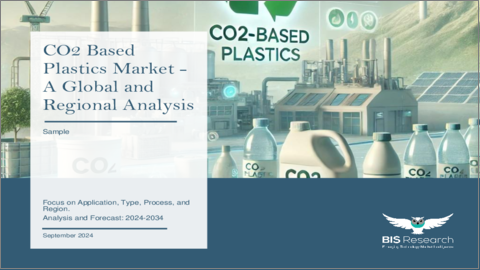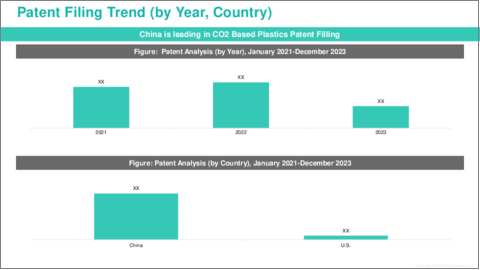|
|
市場調査レポート
商品コード
1560926
CO2ベースのプラスチック市場- 世界および地域別分析:用途別、タイプ別、生産プロセス別、地域別 - 分析と予測(2024年~2034年)CO2 Based Plastics Market - A Global and Regional Analysis: Focus on Application, Type, Process, and Region - Analysis and Forecast, 2024-2034 |
||||||
カスタマイズ可能
|
|||||||
| CO2ベースのプラスチック市場- 世界および地域別分析:用途別、タイプ別、生産プロセス別、地域別 - 分析と予測(2024年~2034年) |
|
出版日: 2024年09月25日
発行: BIS Research
ページ情報: 英文 100 Pages
納期: 1~5営業日
|
- 全表示
- 概要
- 目次
CO2ベースのプラスチックの市場規模は、様々な市場促進要因に後押しされ、著しい成長を遂げています。
楽観的シナリオでは、2024年の市場規模は28億2,000万米ドルになるとみられ、11.40%のCAGRで拡大し、2034年には82億9,000万米ドルに達すると予測されています。
CO2ベースのプラスチック市場は、主に環境への関心の高まりと温室効果ガス排出量削減の急務によって牽引されています。気候変動に対する世界の意識が高まるにつれ、政府、産業界、消費者から持続可能な実践に向けた大きな後押しがあります。最も説得力のある推進力のひとつは、CO2ベースのプラスチックが二酸化炭素を隔離し、主要な汚染物質を貴重な原料に変える能力を持っていることです。このプロセスは、二酸化炭素排出量全体の削減に役立つだけでなく、世界の二酸化炭素削減目標や環境規制にも合致しています。新興国政府は、CO2ベースのプラスチックを含むグリーンテクノロジーの開発と採用を促進するための政策やインセンティブをますます導入しており、市場の成長をさらに後押ししています。
| 主要市場統計 | |
|---|---|
| 予測期間 | 2024年~2034年 |
| 2024年の評価 | 28億2,000万米ドル |
| 2034年の予測 | 82億9,000万米ドル |
| CAGR | 11.4% |
もう一つの重要な促進要因は、高分子化学分野における技術の進歩と革新です。研究者や企業は、CO2から高品質のポリマーへの変換を可能にする効率的な触媒プロセスの開発において大きな進歩を遂げています。このような技術的進歩により、CO2ベースのプラスチックの性能特性が向上し、化石燃料由来の従来のプラスチックに代わる実行可能な選択肢となっています。さらに、包装、自動車、消費財など様々な産業において、持続可能で環境に優しい材料への需要が高まっていることも、市場を前進させています。企業は持続可能性のプロファイルを強化し、グリーン製品に対する消費者の需要に応えようとする傾向が強まっており、それによってCO2ベースのプラスチックの採用が促進されています。環境上の利点、規制による支援、技術の進歩が組み合わさることで、CO2ベースのプラスチック市場が急成長するための強固な基盤が形成されています。
アジア太平洋は、力強い産業成長、政府による支援政策、環境持続可能性への意識が高まる消費者層が相まって、CO2ベースのプラスチックの最大市場となっています。この地域の国々、特に中国、日本、韓国は、CO2を大量に排出する広範な産業活動を行う主要な製造拠点です。CO2ベースのプラスチックを採用することで、これらの国々は環境問題に取り組むと同時に、豊富で安価な原料である二酸化炭素を利用することができます。
当レポートでは、世界のCO2ベースのプラスチック市場について調査し、市場の概要とともに、用途別、タイプ別、生産プロセス別、地域別の動向、および市場に参入する企業のプロファイルなどを提供しています。
目次
エグゼクティブサマリー
第1章 市場:業界の展望
- 動向:現在および将来の影響評価
- サプライチェーンの概要
- R&Dレビュー
- 規制状況
- ステークホルダー分析
- 主要な世界的イベントの影響分析
- 市場力学の概要
第2章 CO2ベースのプラスチック市場(用途別)
- 用途のセグメンテーション
- 用途の概要
- CO2ベースのプラスチック市場(用途別)
第3章 CO2ベースのプラスチック市場(製品別)
- 製品セグメンテーション
- 製品概要
- CO2ベースのプラスチック市場(タイプ別)
- CO2ベースのプラスチック市場(生産プロセス別)
第4章 CO2ベースのプラスチック市場(地域別)
- CO2ベースのプラスチック市場(地域別)
- 北米
- 欧州
- アジア太平洋
- その他の地域
第5章 企業プロファイル
- 今後の見通し
- 地理的評価
- Asahi Kasei
- Covestro
- Empower Materials
- Changhua Chemical Technology Company Ltd.
- LanzaTech
- Saudi Aramco
- NatureWorks
- TotalEnergies Corbion
- Cardia Bioplastics
- Avantium
- SK Innovation Co, Ltd
第6章 調査手法
Introduction to CO2 Based Plastics Market
The CO2-based plastics market is undergoing significant growth, propelled by various key factors and market drivers. In an optimistic scenario, the market is evaluated at a valuation of $2.82 billion in 2024 and is projected to expand at a CAGR of 11.40% to reach $8.29 billion by 2034.
The CO2-based plastics market is primarily driven by the growing environmental concerns and the urgent need to reduce greenhouse gas emissions. As global awareness about climate change intensifies, there is a significant push from governments, industries, and consumers towards sustainable practices. One of the most compelling drivers is the ability of CO2-based plastics to sequester carbon dioxide, converting a major pollutant into a valuable raw material. This process not only helps in reducing the overall carbon footprint but also aligns with global carbon reduction targets and environmental regulations. Governments are increasingly implementing policies and incentives to promote the development and adoption of green technologies, including CO2-based plastics, further fueling market growth.
| KEY MARKET STATISTICS | |
|---|---|
| Forecast Period | 2024 - 2034 |
| 2024 Evaluation | $2.82 Billion |
| 2034 Forecast | $8.29 Billion |
| CAGR | 11.4% |
Another key driving factor is the advancements in technology and innovation in the field of polymer chemistry. Researchers and companies are making significant strides in developing efficient catalytic processes that enable the conversion of CO2 into high-quality polymers. These technological advancements have led to improved performance characteristics of CO2-based plastics, making them viable alternatives to conventional plastics derived from fossil fuels. Additionally, the rising demand for sustainable and eco-friendly materials in various industries such as packaging, automotive, and consumer goods is propelling the market forward. Companies are increasingly seeking to enhance their sustainability profiles and meet consumer demand for green products, thereby driving the adoption of CO2-based plastics. The combination of environmental benefits, regulatory support, and technological progress creates a robust foundation for the rapid growth of the CO2-based plastics market.
The Asia-Pacific region is the largest market for CO2-based plastics due to a combination of strong industrial growth, supportive government policies, and a significant consumer base that is increasingly conscious of environmental sustainability. Countries in this region, particularly China, Japan, and South Korea, are major manufacturing hubs with extensive industrial activities that generate substantial CO2 emissions. The adoption of CO2-based plastics allows these countries to address environmental concerns while also tapping into an abundant and inexpensive source of raw material-captured carbon dioxide.
Furthermore, governments in the Asia-Pacific region are implementing stringent environmental regulations and providing incentives to promote sustainable practices and reduce carbon emissions. These policies are fostering innovation and investment in green technologies, including CO2-based plastics. Additionally, the rapid urbanization and economic growth in the region are driving the demand for sustainable materials across various sectors such as packaging, automotive, and construction. The combination of regulatory support, industrial capability, and market demand positions the Asia-Pacific region as a leader in the CO2-based plastics market, driving its expansion and development.
Market Segmentation:
Segmentation 1: by Application
- Packaging
- Films
- Bottles
- Containers
- Trays
- Automotive Components
- Interior Components
- Structural Parts
- Construction Materials
- Pipes
- Panels
- Insulation
- Electronics Components
- Casings
- Connectors
- Circuit Boards
- Textile Processing
- Fibers
- Non-Woven Fabrics
- Others (Medical Devices, Consumer Goods)
Segmentation 2: by Type
- Polycarbonates
- Polyurethanes
- Polypropylene Carbonate (PPC)
- Polyethylene Carbonate (PEC)
- Polyhydroxyalkanoates (PHAs)
- Others (PMMA, PLA)
Segmentation 3: by Production Process
- Electrochemistry
- Microbial Synthesis
- Thermocatalysis
Segmentation 4: by Region
- North America
- Europe
- Asia-Pacific
- Rest-of-the-World
How can this report add value to an organization?
Product/Innovation Strategy: The global CO2 based plastics market has been extensively segmented based on various categories such as application, type, and production process. This can help readers get a clear overview of which segments account for the largest share and which ones are well-positioned to grow in the coming years.
Competitive Strategy: A detailed competitive benchmarking of the players operating in the global CO2 based plastics market has been done to help the reader understand how players stack against each other, presenting a clear market landscape. Additionally, comprehensive competitive strategies such as partnerships, agreements, and collaborations will aid the reader in understanding the untapped revenue pockets in the market.
Key Market Players and Competition Synopsis
The companies that are profiled have been selected based on thorough secondary research, which includes analyzing company coverage, product portfolio, market penetration, and insights gathered from primary experts.
Some of the prominent companies in this market are:
- Asahi Kasei
- Covestro
- Empower Materials
- Changhua Chemical Technology Company Ltd.
- LanzaTech
- NatureWorks
Key Questions Answered in this Report:
- What are the main factors driving the demand for CO2 based plastics?
- What are the major patents filed by the companies active in the CO2 based plastics market?
- Which are the key players in theCO2 based plastics market, and what are their respective market shares?
- What partnerships or collaborations are prominent among stakeholders in the CO2 based plastics market?
- What are the strategies adopted by the key companies to gain a competitive edge in the CO2 based plastics market?
- What is the futuristic outlook for the CO2 based plastics market in terms of growth potential?
- What is the current estimation of the CO2 based plastics market, and what growth trajectory is projected from 2024 to 2034?
- Which application and product segments are expected to lead the market over the forecast period 2024-2034?
- Which regions demonstrate the highest adoption rates for CO2 based plastics, and what factors contribute to their leadership?
Table of Contents
Executive Summary
Scope and Definition
Market/Product Definition
Key Questions Answered
Analysis and Forecast Note
1. Markets: Industry Outlook
- 1.1 Trends: Current and Future Impact Assessment
- 1.1.1 Increasing Focus Towards Carbon Capture and Utilization.
- 1.1.2 Growing Consumer Demand for Eco-Friendly Products
- 1.2 Supply Chain Overview
- 1.2.1 Value Chain Analysis
- 1.2.2 Pricing Forecast
- 1.3 R&D Review
- 1.3.1 Patent Filing Trend by Country, by Company
- 1.4 Regulatory Landscape
- 1.5 Stakeholder Analysis
- 1.5.1 Use Case
- 1.5.2 End User and Buying Criteria
- 1.6 Impact Analysis for Key Global Events
- 1.7 Market Dynamics Overview
- 1.7.1 Market Drivers
- 1.7.2 Market Restraints
- 1.7.3 Market Opportunities
2. CO2 Based Plastics Market (by Application)
- 2.1 Application Segmentation
- 2.2 Application Summary
- 2.3 CO2 Based Plastics Market by Application
- 2.3.1 Packaging
- 2.3.1.1 Films
- 2.3.1.2 Bottles
- 2.3.1.3 Containers
- 2.3.1.4 Trays
- 2.3.2 Automotive Components
- 2.3.2.1 Interior Components
- 2.3.2.2 Structural Parts
- 2.3.3 Construction Materials
- 2.3.3.1 Pipes
- 2.3.3.2 Panels
- 2.3.3.3 Insulation
- 2.3.4 Electronics Components
- 2.3.4.1 Casings
- 2.3.4.2 Connectors
- 2.3.4.3 Circuit Boards
- 2.3.5 Textile Processing
- 2.3.5.1 Fibers
- 2.3.5.2 Non-Woven Fabrics
- 2.3.6 Others (Medical Devices, Consumer Goods)
- 2.3.1 Packaging
3. CO2 Based Plastics Market (by Products)
- 3.1 Product Segmentation
- 3.2 Product Summary
- 3.3 CO2 Based Plastics Market by Type
- 3.3.1 Polycarbonates
- 3.3.2 Polyurethanes
- 3.3.3 Polypropylene Carbonate (PPC)
- 3.3.4 Polyethylene Carbonate (PEC)
- 3.3.5 Polyhydroxyalkanoates (PHAs)
- 3.3.6 Others (PMMA, PLA)
- 3.4 CO2 Based Plastics Market by Production Process
- 3.4.1 Electrochemistry
- 3.4.2 Microbial Synthesis
- 3.4.3 Thermocatalysis
4. CO2 Based Plastics Market (by Region)
- 4.1 CO2 Based Plastics Market - by Region
- 4.2 North America
- 4.2.1 Regional Overview
- 4.2.2 Driving Factors for Market Growth
- 4.2.3 Factors Challenging the Market
- 4.2.4 Application
- 4.2.5 Product
- 4.2.6 U.S.
- 4.2.6.1 Market by Application
- 4.2.6.2 Market by Product
- 4.2.7 Canada
- 4.2.7.1 Market by Application
- 4.2.7.2 Market by Product
- 4.2.8 Mexico
- 4.2.8.1 Market by Application
- 4.2.8.2 Market by Product
- 4.3 Europe
- 4.3.1 Regional Overview
- 4.3.2 Driving Factors for Market Growth
- 4.3.3 Factors Challenging the Market
- 4.3.4 Application
- 4.3.5 Product
- 4.3.6 Germany
- 4.3.6.1 Market by Application
- 4.3.6.2 Market by Product
- 4.3.7 France
- 4.3.7.1 Market by Application
- 4.3.7.2 Market by Product
- 4.3.8 U.K.
- 4.3.8.1 Market by Application
- 4.3.8.2 Market by Product
- 4.3.9 Italy
- 4.3.9.1 Market by Application
- 4.3.9.2 Market by Product
- 4.3.10 Spain
- 4.3.10.1 Market by Application
- 4.3.10.2 Market by Product
- 4.3.11 Rest-of-Europe
- 4.3.11.1 Market by Application
- 4.3.11.2 Market by Product
- 4.4 Asia-Pacific
- 4.4.1 Regional Overview
- 4.4.2 Driving Factors for Market Growth
- 4.4.3 Factors Challenging the Market
- 4.4.4 Application
- 4.4.5 Product
- 4.4.6 China
- 4.4.6.1 Market by Application
- 4.4.6.2 Market by Product
- 4.4.7 Japan
- 4.4.7.1 Market by Application
- 4.4.7.2 Market by Product
- 4.4.8 India
- 4.4.8.1 Market by Application
- 4.4.8.2 Market by Product
- 4.4.9 South Korea
- 4.4.9.1 Market by Application
- 4.4.9.2 Market by Product
- 4.4.10 Rest-of-Asia-Pacific
- 4.4.10.1 Market by Application
- 4.4.10.2 Market by Product
- 4.5 Rest-of-the-World
- 4.5.1 Regional Overview
- 4.5.2 Driving Factors for Market Growth
- 4.5.3 Factors Challenging the Market
- 4.5.4 Application
- 4.5.5 Product
- 4.5.6 South America
- 4.5.6.1 Market by Application
- 4.5.6.2 Market by Product
- 4.5.7 Middle East and Africa
- 4.5.7.1 Market by Application
- 4.5.7.2 Market by Product
5. Companies Profiled
- 5.1 Next Frontiers
- 5.2 Geographic Assessment
- 5.2.1 Asahi Kasei
- 5.2.1.1 Overview
- 5.2.1.2 Top Products/Product Portfolio
- 5.2.1.3 Top Competitors
- 5.2.1.4 Target Customers
- 5.2.1.5 Key Personnel
- 5.2.1.6 Analyst View
- 5.2.1.7 Market Share
- 5.2.2 Covestro
- 5.2.2.1 Overview
- 5.2.2.2 Top Products/Product Portfolio
- 5.2.2.3 Top Competitors
- 5.2.2.4 Target Customers
- 5.2.2.5 Key Personnel
- 5.2.2.6 Analyst View
- 5.2.2.7 Market Share
- 5.2.3 Empower Materials
- 5.2.3.1 Overview
- 5.2.3.2 Top Products/Product Portfolio
- 5.2.3.3 Top Competitors
- 5.2.3.4 Target Customers
- 5.2.3.5 Key Personnel
- 5.2.3.6 Analyst View
- 5.2.3.7 Market Share
- 5.2.4 Changhua Chemical Technology Company Ltd.
- 5.2.4.1 Overview
- 5.2.4.2 Top Products/Product Portfolio
- 5.2.4.3 Top Competitors
- 5.2.4.4 Target Customers
- 5.2.4.5 Key Personnel
- 5.2.4.6 Analyst View
- 5.2.4.7 Market Share
- 5.2.5 LanzaTech
- 5.2.5.1 Overview
- 5.2.5.2 Top Products/Product Portfolio
- 5.2.5.3 Top Competitors
- 5.2.5.4 Target Customers
- 5.2.5.5 Key Personnel
- 5.2.5.6 Analyst View
- 5.2.5.7 Market Share
- 5.2.6 Saudi Aramco
- 5.2.6.1 Overview
- 5.2.6.2 Top Products/Product Portfolio
- 5.2.6.3 Top Competitors
- 5.2.6.4 Target Customers
- 5.2.6.5 Key Personnel
- 5.2.6.6 Analyst View
- 5.2.6.7 Market Share
- 5.2.7 NatureWorks
- 5.2.7.1 Overview
- 5.2.7.2 Top Products/Product Portfolio
- 5.2.7.3 Top Competitors
- 5.2.7.4 Target Customers
- 5.2.7.5 Key Personnel
- 5.2.7.6 Analyst View
- 5.2.7.7 Market Share
- 5.2.8 TotalEnergies Corbion
- 5.2.8.1 Overview
- 5.2.8.2 Top Products/Product Portfolio
- 5.2.8.3 Top Competitors
- 5.2.8.4 Target Customers
- 5.2.8.5 Key Personnel
- 5.2.8.6 Analyst View
- 5.2.8.7 Market Share
- 5.2.9 Cardia Bioplastics
- 5.2.9.1 Overview
- 5.2.9.2 Top Products/Product Portfolio
- 5.2.9.3 Top Competitors
- 5.2.9.4 Target Customers
- 5.2.9.5 Key Personnel
- 5.2.9.6 Analyst View
- 5.2.9.7 Market Share
- 5.2.10 Avantium
- 5.2.10.1 Overview
- 5.2.10.2 Top Products/Product Portfolio
- 5.2.10.3 Top Competitors
- 5.2.10.4 Target Customers
- 5.2.10.5 Key Personnel
- 5.2.10.6 Analyst View
- 5.2.10.7 Market Share
- 5.2.11 SK Innovation Co, Ltd
- 5.2.11.1 Overview
- 5.2.11.2 Top Products/Product Portfolio
- 5.2.11.3 Top Competitors
- 5.2.11.4 Target Customers
- 5.2.11.5 Key Personnel
- 5.2.11.6 Analyst View
- 5.2.11.7 Market Share
- 5.2.1 Asahi Kasei






